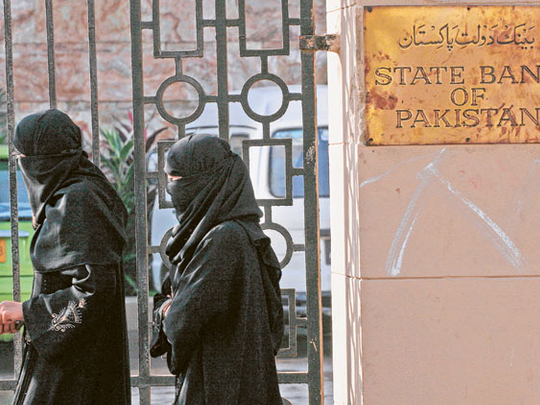
Dubai: The State Bank of Pakistan (SBP), Pakistan's central bank, has recently warned that the banks in the country are facing deteriorating credit quality despite a strong trend of banks investing heavily in government debt.
According to the SBP's recent Financial Stability Review (FSR) of Pakistan, the credit risk-weighted assets (CRWA) of banks grew by two per cent or Rs65 billion during the first half of this year and credit risk remains very high despite banks' growing investments in government debt instruments, which are mainly called the safest investment in the banking industry.
The SBP said the falling CRWA to total assets over the last few years was not an indicator of lower credit risk; rather it simply suggested a strong flight to quality amid high non-performing loans (NPLs).
The report said that to prevent a further increase in the NPLs, the banks tried to limit their bad loans by tightening their credit standards, significantly restricting their lending to riskier sectors such as small and medium enterprises (SMEs) and retail consumers.
In addition, banks also liberally increased their investments in government debt.
Government debt
Independent analysts and rating agencies say the banks' excessive exposure to government debt makes them vulnerable to the weak operating environment and high concentration of assets. In a recent report Moody's said the outlook for Pakistan's banking system remains negative.
The rating agency said the outlook reflects two key drivers such as the weak operating environment and the likelihood of banks increasing their already high exposures to the Pakistan government.
"While the weak operating environment faces further downside risks, increases in the banks' exposures to the sovereign make the sector's solvency increasingly vulnerable to sovereign credit risk," said Christos Theofilou, Analyst, Financial Institutions Group at Moody's.
Analysts view the rush of banks to take exposure to government debt as a structural limitation of the banking sector.
Pakistan has a projected budget deficit equivalent to 5.4 per cent of GDP in fiscal year 2012, Moody's believes that the banking sector will further increase its already significant exposure to the government and public sector, which the rating agency estimates at 31 per cent of total assets or 350 per cent of Tier 1 capital, as of end-2010.
The SBP report said that Pakistan's banking system remains resilient against major foreseeable shocks, however the central bank acknowledged that the adverse economic outlook and structural deficiencies in the economy are taking their toll on the debt repayment capacity of the borrowers, and the deterioration in economic indicators, as measured by a faltering GDP growth has led to a surge in NPLs.
NPLs of the banking sector increased from 14.7 per cent to 15.3 per cent, or Rs31.4 billion, in the first half of this year over the same period last year.
Revival
"The fact that NPLs continue to build up underscores the intractable nature of heightened credit risk," the SBP report said.
Moody's said factors such as a revival in short-term economic growth, lower interest rates and de-risking of the banks' loan book could stabilise asset-quality metrics.
The NPLs for the year are expected to peak at around 16 per cent of total lending this year, from 15.3 per cent at end-June 2011, and then remain at these elevated levels throughout 2012.
Analysts said as a counterbalance to the system's structural challenges, the banks benefit from sound funding profiles and low-cost current and savings account deposits, which amounted to 67 per cent of total deposits or 56 per cent of total liabilities at end-June 2011.
"Banks' reliance on market and/or foreign funding also remains minimal. However, we believe that related vulnerabilities will persist, namely the short contractual maturities of customer deposits that create asset-liability mismatches and high government-deposit concentrations," said Theofilou.












